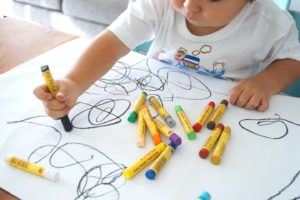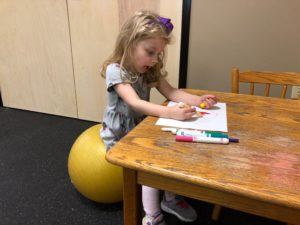Month: January 2020
Starting at the age of 2, children begin to learn how to draw basic lines and shapes. It is developmentally appropriate for your child to draw a vertical line by 2 years old, horizontal line by 2.5 years old, a circle by 3 years, a cross by 3.5 years old, and a square at 4 years old. By the age of 5, children should be coloring inside of lines independently without any deviations. Children in kindergarten will be introduced to forming letters in the alphabet, if not beforehand in pre-school. Children should have emerging hand preference by the age of 18 months, increasing preference by age 2, with hand dominance firmly established by the age of 3.5 years. These are important fine motor skills to develop as functional handwriting progresses in first and second grade. Incorporating sensory techniques and repetition help increase the motor learning. Children also enjoy the response of sensory feedback during activities. Movement and sensory feedback help increase a child’s focus, learning ability, body awareness, and memory.

Various sensory motor activities can be used to facilitate fun with handwriting!
• Using popsicle sticks to form uppercase letters with straight lines
o one popsicle stick being 1 single side
o use a finger tip, then also crayon or marker to trace over top each popsicle stick to re-enforce that motor learning for each letter multiple trials
• Using Wiki-Sticks to form any shapes or letters, then trace over shape or letter formed with finger
o Including verbal prompts when tracing over top can facilitate speech and language, and also give auditory feedback for better learning
• Use a mini chalkboard to form shape or letter with chalk, then go over it with a wet sponge, and finally trace over with a paper towel to dry
• Use shaving cream or sensory medium for messy play (pudding, whip cream, yogurt, finger paint) to draw shapes and letters in with finger tip
• Manipulate play-doh by using hands to roll play doh into short or medium sized “logs” and form into shapes and letters
o Then use finger tips to press or smash down on flat surface as repetition, while using prompts to name letter or reiterate type of strokes used to form shape or letter
• Using Q-tips and paint, make dots to form shapes or letters
o Once dry, use a crayon or marker to connect the dots

Visit www.abcpediatrictherapy.com for more!
Read More Skip to content
Skip to content